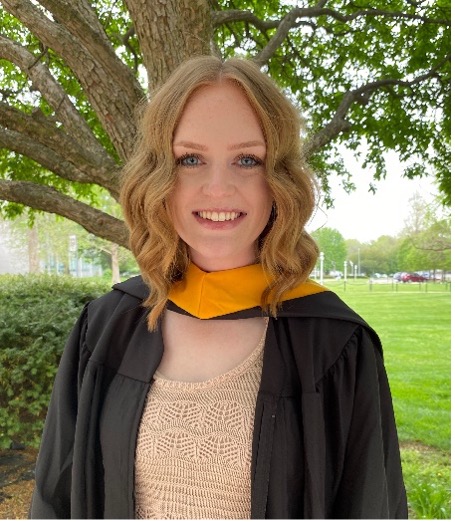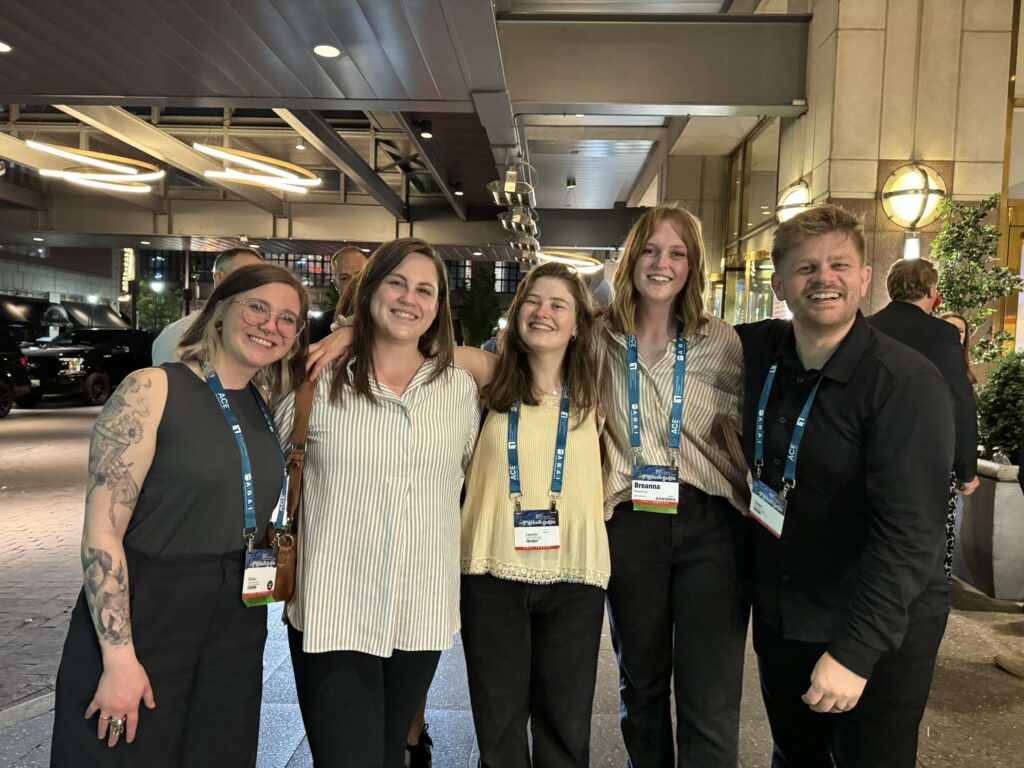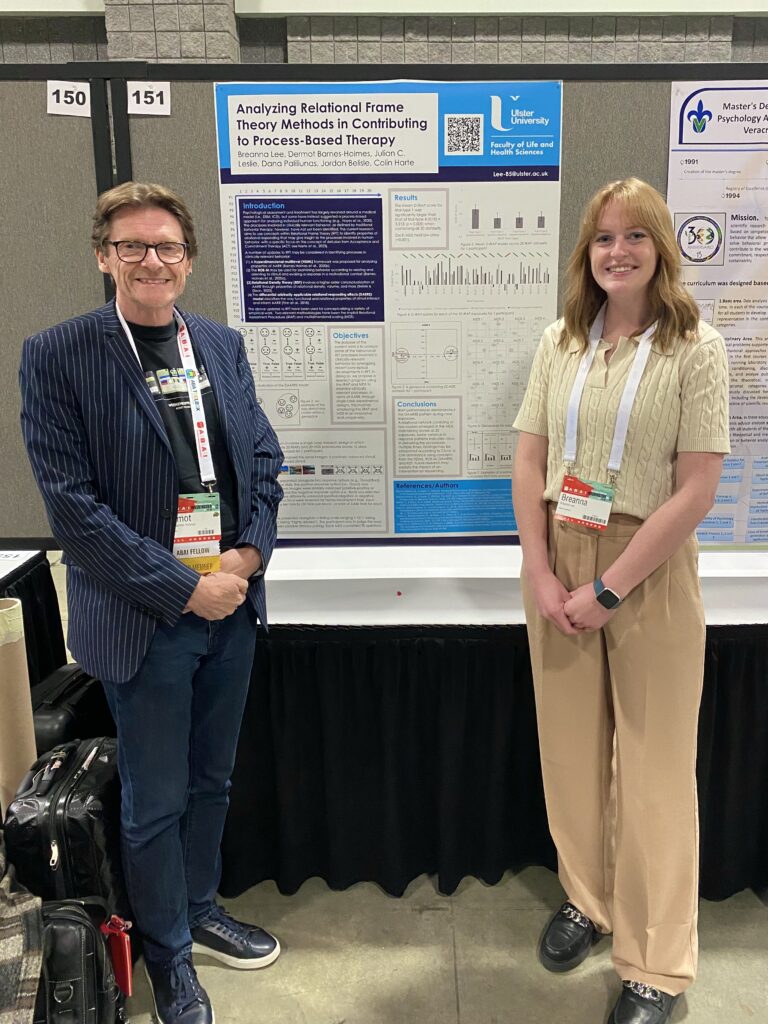Dear blog reader,
This month we are joined by Breanna Lee, a doctoral candidate at Ulster University in Northern Ireland. Breanna’s trajectory to this point has been a fascinating one, involving the type of cooperation and collaboration that has come to characterise the current blog series in the service of her research interests and goals. Breanna’s research story has taken her from Missouri USA, all the way to Coleraine Northern Ireland, and involved exploring and bringing together perspectives such as relational frame theory (RFT), relational density theory (RDT), and acceptance and commitment therapy (ACT). Breanna has applied these perspectives in novel and creative ways to important social issues like stereotyping and sexuality, college student academic experiences, and psychological well being more generally. Critically, what has characterised much of Breanna’s work, and indeed what drives her cutting edge PhD research, is the pursuit of increasingly precise process-based analyses of clinical issues. If we as a field are to contribute to individualised clinical interventions, based in precise behavior-analytic concepts, this is the type of work, and approach to that work, that arguably needs to be undertaken. Over to you, Breanna!
About the author:

Breanna Lee is a clinical behavior scientist from the United States. She studied at Missouri State University for her Bachelor of Science degree in psychology and Master of Science degree in clinical psychology. There, she accumulated extensive research experience in both clinical and behavior analytic topics, primarily involving Relational Frame Theory and the role of verbal behavior in psychological well-being. Breanna is currently residing in Northern Ireland while completing her PhD in psychology at Ulster University. She has regularly presented at ABAI (and other) conferences and has held teaching and learner support roles at Missouri State and Ulster. She also has experience in clinical intervention in contexts of psychotherapy, self-management, and interdisciplinary programs using Acceptance and Commitment Therapy. Breanna will graduate with her PhD in 2026 and continue a career in academia.
Merging Perspectives for a Stronger Science
I grew up surrounded by cornfields in rural Missouri, where the main attractions were a gas station and the annual mule festival. As endearing as this was, the area was not exactly bursting with opportunities for kids interested in progressive social sciences. I was fortunate in that my parents strongly encouraged higher education (and remain my biggest supporters), so I enrolled at Missouri State University as a first-generation college student.
When I began my studies, I was attracted to mentalism and a career in clinical psychology, similar to most undergraduate students. Strangely, I ended up in an upper-level Introduction to ABA course during my first semester. The course was taught by Dr. Dana Paliliunas who, at the time, had just started teaching at the university and was recruiting students to join her Language and Behavior research lab. I’m still not sure why she accepted me into her lab – I was a first-year student, had no research skills, and knew nothing about behavior analysis. But she took me under her wing, of sorts, and I worked under her supervision for all three years of my undergraduate studies. Through Dana, I met Dr. Jordan Belisle and began collaborating with him on various projects, as well. While working with Dana and Jordan, I was quickly introduced to Relational Frame Theory (RFT; Hayes et al., 2001) and Acceptance & Commitment Therapy (ACT; Hayes et al., 1999), and how concepts from these may be of use in tackling issues most commonly addressed from a mentalistic standpoint (at least in mainstream psychology).

Admittedly, I was not completely sold on behavior analysis from the start. I stubbornly enrolled in a clinical psychology master’s program at Missouri State; and over these two years, I took courses on standardized assessments and psychotherapy, primarily drawing on the medical model and cognitive-based approaches. I was also taking extra courses through the counseling department and working as an intern therapist at a counseling center. I didn’t completely pivot away from behavior analysis, though. I continued my RFT and ACT work with Dana and Jordan through a funded research assistantship during my master’s. This made for an interesting experience, where I was being trained through the medical model (in clinical psychology), but was “dabbling” in two other fields (counseling and behavior analysis), both of which largely reject putting emphasis on the medical model in guiding treatment (and for very different reasons). The combination of these approaches ultimately informed the path I’m currently taking in my research. For greater context, though, I’ll first describe some of the studies I completed with Dana and Jordan that were important in my identity development as a behavior analytic researcher.
Early into my master’s, the lab had started using multidimensional scaling (MDS) to visually map out stimuli within a relational network (see Belisle & Clayton, 2021 for a description of this statistical procedure). We saw the MDS as an exciting tool for illustrating relational responding according to properties of density, volume, and mass, as outlined by Relational Density Theory (Belisle & Dixon, 2020). As part of my master’s thesis, Dana and I conducted a study analyzing stereotypes related to sexuality by inputting identity words (e.g., straight man, lesbian woman, bisexual man, etc.) and descriptor words (e.g., natural, confused, realistic, etc.) into the MDS as a pre- and post-test (Lee & Paliliunas, in press). Between MDS phases, participants were either exposed to a brief online defusion activity from ACT or a control condition. Pre-test results illustrated graded structures of categorization consistent with androcentrism and heteronormativity (Bailey et al., 2019; Bem, 1993; Van der Toorn et al., 2020; Warner, 1991), in which several appetitive descriptors (e.g., natural, realistic, monogamous) were most closely related to straight men relative to all other identities, and more closely related to straight women relative to LGB identities. At post-test, notable changes in responding occurred for the experimental group (and not for the control group), in which relations involved in stereotyping appeared to diffuse. Not only did this suggest that ACT may have use in targeting relational frames involved in prejudice, but it also inspired us to continue exploring how the MDS may be used in other contexts. One of these contexts was assessing verbal relations involved in psychological well-being.
The first project that Dana and I used the MDS for assessing psychological well-being was centered around understanding college students’ academic experiences. Two studies from this work are detailed in Paliliunas et al. (2024). Study 1 involved a simple between-group experiment, in which MDS responding was compared between high- and low-psychological flexibility groups. The MDS contained stimuli related to the self, academia, positive affect, and negative affect. We observed a clear visual difference in responding between groups, particularly involving the self-stimulus. The high-flexibility group closely related the self-stimulus to education goals and positive affect, whereas the low-flexibility group closely related the self-stimulus to thoughts and emotions. These findings suggested to us that the MDS may be a useful tool for illustrating the nature and density of relations that impact psychological well-being. We were particularly interested in whether this approach could translate into clinical settings, in which MDS results aid the development of treatment plans and monitor the effectiveness of treatment over time. This empirical question led us to Study 2: a values-based self-management (VBSM) program for college students on academic probation.
Dana created the VBSM program from the ground up, and I was fortunate to be brought on as a lead facilitator. Our purpose was to use strategies based in self-management and ACT to support students in improving their academic behavior. Study 2 in Paliliunas et al. (2024) features one case from the VBSM program. At intake, the participant (an undergraduate student on academic probation) completed a similar MDS to Study 1, several well-being self-reports, and a structured interview. We identified a target behavior – time spent preparing for assignments – and addressed it through a 9-week intervention involving weekly one-hour sessions structured around ACT hexaflex processes, selected based on intake data. Additionally, we collected self-monitoring data across an 11-day baseline and the 9-week intervention period, in which the participant reported the amount of time she engaged in the target behavior each day. Post-test results showed an increase in the target behavior, improvements on most of the self-report measures of well-being, and a GPA increase that was large enough to restore the participant’s status of good academic standing. Finally, we observed a notable difference in pre- and post-MDS responses that aligned with Study 1. When the participant reported lower psychological flexibility at pre-test, her MDS results demonstrated very dense relations between the self, goals, thoughts, and negative affect. At post-test, psychological flexibility had improved and the relations were much less dense. Specifically, the self-stimulus was observed as more balanced in degree of relatedness between the positive and negative affect stimulus groups.

The VBSM program impacted my research interests in two major ways. First, I was excited by the MDS as a way of observing properties of relational responding, especially in the context of psychological well-being. Second, I saw first-hand the power of individualized clinical intervention based in behavior analytic concepts. This latter point, specifically, was very different from much of the practical experience I was getting through my clinical psychology courses. I understood the benefits to using a medical model for psychological assessment, but I felt like I was running in circles trying to use such a model for effectively guiding evidence-based treatment. The VBSM program, as an example of how strategies within behavior analysis could be implemented in clinical contexts, seemed much more scientific. Thus, the combination of these experiences as a clinical psychology student doing behavior analytic research were critical in realizing that I was less interested in clinical psychology, per say, and more interested in an academic career in clinical behavior science.
By the end of my master’s program, Dana and Jordan got word of a PhD position available with Professor Dermot Barnes-Holmes in Northern Ireland, and encouraged me to apply. I was skeptical at first, because moving out of the United States seemed unrealistic for myself – at this point, I hadn’t even lived outside of my home state. However, the research Dermot had proposed for the position was exactly what I was looking for in a PhD program. It was innovative, and aimed to use concepts from RFT and ACT to address some of the issues I had noticed in mainstream psychology, as well as other research gaps within the ACT literature. So I submitted an application to Ulster University and to my surprise, I was accepted into the program.
I’m now living in Northern Ireland and have been working with Dermot for two years. In starting my PhD, I met my secondary supervisor, Professor Julian C. Leslie, who quickly became a valued mentor to me. We also added external supervisors to support the project, including Dana and Jordan, as well as Dr. Colin Harte, who I was eager to work with. Needless to say, living abroad and working under this supervisory team is beyond anything I imagined for myself, and I consider it to be an immense privilege.

The transition into my PhD was a relatively smooth one. Right away, I dove into the literature on “updated RFT” (Barnes-Holmes et al., 2020). While initially daunting to me, I soon became well-versed in the analytic tools Dermot and many of his collaborators had been using in advancing RFT. My previous work involving the MDS for RDT analyses aligned well with Dermot’s use of the Implicit Relational Assessment Procedure (IRAP; Barnes-Holmes et al., 2006) for capturing properties of arbitrarily applicable relational responding. Specifically, a differential arbitrarily applicable relational responding effects (DAARRE) model was developed for summarizing a trend in IRAP performances, in which the functional (Cfunc) properties of stimuli appeared to dominate responding relative to relational (Crel) properties (Finn et al., 2018). This finding was a useful guide for developing my PhD research, as we began exploring how the IRAP and MDS may contribute to identifying processes involved in clinically-relevant behavior.
Several research questions driving my PhD were inspired by the process-based approach being developed within contextual behavior science (Hayes et al., 2020), primarily involving the term, ‘process’ and whether this term is used in the same way across traditional behavior analytic, RFT, and ACT conceptualizations. As it stands, it is unclear what exactly a behavioral process is within ACT, apart from the middle-level terms employed by the hexaflex and a more recent extended evolutionary meta-model. Thus, current process-based analyses appear to be missing the level of precision and scope that is typically emphasized in traditional behavior therapy. The overarching purpose of my PhD is to use the IRAP and MDS to contribute to these process-based analyses by predicting and influencing properties of relational responding in pursuit of better understanding clinically relevant behavior among individual clients.
We first decided to test how the IRAP and MDS may be similar or different in the way they capture Cfunc and Crel properties. In a between-groups study, participants completed either an IRAP or MDS containing a series of images ranging in valence and arousal. The IRAP group showed a mean pattern of responding consistent with the DAARRE model, as we had expected. The MDS group demonstrated a mean pattern in which stimuli appeared to cluster according to a combination of their relational and functional properties. These results provided a foundation for us to continue exploring the IRAP and MDS through a synergized methodology.
The next phase of my research involved two key components that had been missing from much of the literature addressing clinical issues: (1) single case analyses; and (2) taking multiple samples of data over time. Both are characteristic of traditional behavior analytic research, but less so for studies using concepts from RFT. It seemed necessary to go in this direction, as a process-based approach absolutely requires individualized analyses beyond momentary snapshots of behavior. Thus, we designed a program in which participants would complete both, the IRAP and the MDS, twice per day across ten days to obtain a total of 40 datasets (20 IRAPs and 20 MDSs) for every participant. Part of this method had been tested by Dermot and Colin with the IRAP (manuscript in preparation), but such a method had never been conducted with the MDS.
So far, we have administered variations of the above design to 14 participants, which has produced around 900 datasets total. Data analysis involved examining trends in IRAP and MDS performances across individual exposures, and a number of findings have emerged. First, considerable variability appeared in both IRAP and MDS responses over time, suggesting there is value in administering the procedures more than once to adequately capture more of a behavioral stream. Second, our IRAP data aligns with the DAARRE model, as the relevant pattern of responding appeared on the majority of IRAP exposures for every participant. Third, MDS responding was more variable, but appeared to be most appropriate for analyzing Crel properties of stimuli. Thus, it seems we have two procedures for tapping into different properties of relational responding.
We’re at the point now where we may begin attempting to intervene on participants’ IRAP and MDS performances. Given what we’ve learned so far, we might expect an intervention targeting Cfunc properties to produce changes in IRAP performances, but not in MDS responding; and an intervention targeting Crel properties to produce changes in MDS responding, but not in IRAP performances. Testing the two procedures in this way may then inform how to identify and intervene on processes as properties of relational responding in the context of clinically-relevant behavior. This work is still very much in progress, but we hope it will contribute something meaningful in developing a process-based approach.
In reflecting on my experiences within research and higher education, it seems fitting to re-iterate some of the points Dermot and Colin made in their original introduction to this blog series. Their call for ‘bridging silos’ within the field has become increasingly apparent to myself throughout my (very short) academic career. Indeed, the most formative experiences within my education involved a combination of relatively polarized perspectives. This was true in a literal sense in my studies as a clinical psychology student, counseling intern, and behavior analytic researcher. However, it has also been true in other ways, as an American living in the UK and a first-generation college student studying amongst highly-educated peers and mentors. While these points of polarization bring discomfort, they are vital for growth – for myself as a human and a professional – but also for the very broad field of psychology. This is not a radical point; in fact, I’m sure most would agree with this. However, it seems worth repeating as we continue pushing forward for greater precision, scope, and depth in our understanding of the human condition.
References
Bailey, A. H., LaFrance, M., & Dovidio, J. F. (2019). Is man the measure of all things? A social cognitive account of androcentrism. Personality and Social Psychology Review, 23(4), 307-331. https://doi.org/10.1177/1088868318782848
Barnes-Holmes, D., Barnes-Holmes, Y., & McEnteggart, C. (2020). Updating RFT (more field than frame) and its implications for process-based therapy. The Psychological Record, 70(4), 605-624. https://doi.org/10.1007/s40732-019-00372-3
Barnes-Holmes, D., Barnes-Holmes, Y., Power, P., Hayden, E., Milne, R., & Stewart, I. (2006). Do you really know what you believe? Developing the Implicit Relational Assessment Procedure (IRAP) as a direct measure of implicit beliefs. The Irish Psychologist, 32(7), 169-177.
Belisle, J., & Clayton, M. (2021). Coherence and the merging of relational classes in self-organizing networks: Extending Relational Density Theory. Journal of Contextual Behavioral Science, 20, 118-128. https://doi.org/10.1016/j.jcbs.2021.03.008
Belisle, J., & Dixon, M. R. (2020). Relational Density Theory: Nonlinearity of Equivalence Relating Examined through Higher-Order Volumetric-Mass-Density. Perspectives on Behavior Science, 43, 259-283. https://doi.org/10.1007/s40614-020-00248-w
Bem, S. L. (1993). The lenses of gender: Transforming the debate on sexual inequality. New Haven, CT: Yale University Press.
Finn, M., Barnes-Holmes, D., & McEnteggart, C. (2018). Exploring the single-trial-type-dominance-effect in the IRAP: Developing a differential arbitrarily applicable relational responding effects (DAARRE) model. The Psychological Record, 68(1), 11-25. https://doi.org/10.1007/s40732-017-0262-z
Hayes, S. C., Barnes-Holmes, D., & Roche, B. (Eds.). (2001). Relational frame theory: A post-Skinnerian account of human language and cognition.
Hayes, S. C., Hofmann, S. G., & Ciarrochi, J. (2020). A process-based approach to psychological diagnosis and treatment: The conceptual and treatment utility of an extended evolutionary meta model. Clinical Psychology Review, 82. https://doi.org/10.1016/j.cpr.2020.101908
Hayes, S. C., Strosahl, K. D., & Wilson, K. G. (1999). Acceptance and Commitment Therapy (Vol. 6). New York: Guilford press.
Lee, B. & Paliliunas, D. (in press). Examining Sexuality-Based Stereotypes Through a Relational Density Theory Framework. Behavior & Social Issues.
Paliliunas, D., Lee, B., Barker, K., & Caughron, M. (2024). Verbal relations in the context of university experience: An exploratory analysis using a relational density theoretical framework and case example. Journal of Contextual Behavioral Science, 31. https://doi.org/10.1016/j.jcbs.2023.100719
Van der Toorn, J., Pliskin, R., & Morgenroth, T. (2020). Not quite over the rainbow: The unrelenting and insidious nature of heteronormative ideology. Current Opinion in Behavioral Sciences, 34, 160-165. https://doi.org/10.1016/j.cobeha.2020.03.001
Warner, M. (1991). Introduction: Fear of a Queer Planet. Social Text, 3-17. https://www.jstor.org/stable/466295
